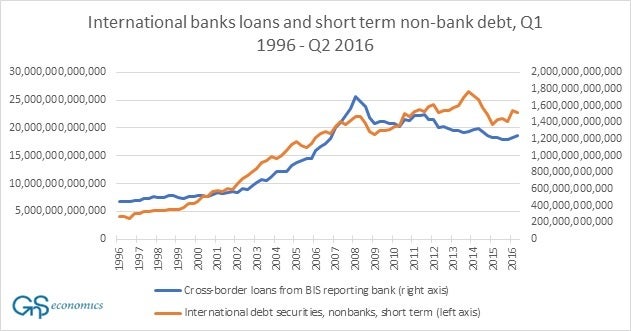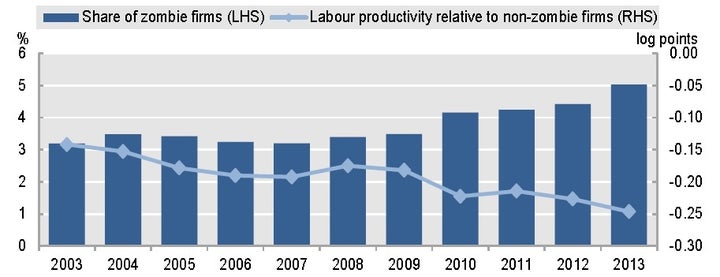When the Great Financial Crisis (GFC) hit in 2008, only few economists thought that the central banks (from now on CBs) would participate the bond and stock markets actively in the following years. Even fewer probably thought that helicopter drops or financing the governments’ deficits would be seriously considered as recession fighting measures of the CBs.
Now all these are true. For example, the Bank of Japan (BoJ) currently owns around 66 % of domestic ETF:s and the Swiss National Bank (SNB) holds around $80 billion worth of stocks of the US companies. The European Central Bank (ECB) owns more than one quarter of the government bond universe and around 11 % of the corporate bonds in Europe. CBs have become massive players in the capital markets, yet economists tend to disregard the risk of the central planning in the capital markets.
GnS Economics has warned about risks of the CB meddling several times. In December 2013, we wrote:
There is a serious possibility that the measures taken by the central banks have already created a situation in which their actions increase rather than decrease financial instability. This is due to the fact that if the actual price of an asset does not meet its market based value, the true level of risk is not properly revealed.
Since then, global central banks’ quantitative easing (QE) and stocks purchase programs have created a situation where one may not speak of market prices, but of artificial centrally planned prices of assets. This means is that the CBs’ have effectively pushed the risks of assets to the far ends of the probability distribution, thus hiding them behind the nearly invisible wall of the CB policy making. This is extraordinarily dangerous.
The problem of recovery
The problem faced by the global CBs after the financial crash can be summarized in one figure. Figure 1 presents the global cross-border loans of banks and international short term non-bank debt securities. It shows that, since 2008, the central bankers have been battling deflationary pressures caused by global financial deleveraging. Although the issuance of the short-term non-bank debt recovered in 2011, just to fall even more dramatically in 2014, the cross-border bank loans have been trending down since the first quarter of 2008.

Because the debt and bank loans create liquidity and thus inflation, diminution of the global debt issuance and especially bank loans would lead to deflation. To fight this, CBs decided to increase liquidity by buying bonds and, later, stocks by newly created money. This has increased the values of the bonds and stocks, pushing the interest rates lower and the stock markets higher. This was supposed to increase the confidence of consumers and businesses, invigorate the global growth and allow the CBs to sell their holdings later. It was a bold plan, but it had two massive caveats.
First, the unorthodox monetary policy measures have inflated a massive global asset bubble as the artificial liquidity has spread throughout the world. Secondly, the risk of assets has been hidden behind the central bankers’ decisions and liquidity, effectively creating a situation where both financial and real economic uncertainty has been decreased to unrealistic levels. One symptom of this is the unnaturally low volatility in the stock markets.
Distortions in the capital markets
The market prices are set according to the scarcity principle, which describes the difference between the scarcity of the resources and the (theoretically) unlimited wants or needs of men. As the market participants have limited resources, the market prices reflect their opinions on the expected risks and gains of all assets traded in the capital markets. The CBs have unlimited resources (the ability to print any amount of legal tender or money). When they take an active role in the markets, the scarcity principle does not hold and prices are set according to the will of the central bank officials. This effectively leads to centrally planned market prices.
In a bit more technical note, the problem of QEs can be summarized by noting that they do not create income or collateral needed to service the elevated asset levels. They just add zeroes to asset prices. A recent study shows that the first QE launched by the FED went into stock prices in the US, but the following two QEs increased capital outflows. What this means is that QEs tend to increase the price of assets both domestically and globally. This is the central bankers’ bubble.
Easy money and zombie firms
The OECD published a revealing research earlier this year. In it, it estimated the number of so called zombie firms, defined as “old firms that have persistent problems meeting their interest payments”, several of its member countries. Figure 2 summarizes their main findings.

It shows that the number of zombie companies have risen quite markedly since 2008, when CBs started their extraordinary monetary policy measures, while the labor productivity has fallen at the same time. Although this is not a definite proof that zero interest rates and QEs are behind this development, historical evidence from Japan shows that providing ailing firms with cheap credit depresses the job creation and hinders productivity growth.
Central bankers’ bubble and the economic doctrine
Central bankers have tried to do their utmost everything to get the global economy growing after the Great Financial Crisis (GFC). Instead of a strong recovery, their unorthodox measures have created a massive asset bubble and diminished the long-run growth prospects of the world economy. The CBs have tried everything because policymakers have expected them to do so. This applies especially to dysfunctional euro area, but also globally.
When the central bankers’ bubble bursts, and burst it will, it might be a good time to think whether the current economic doctrine has been the right one. It is rather clear that the inflation targeting has not worked at least after GFC. NGDP targeting could be more functional. We also need to ask what will be the role of the CBs be in the future. It is evident that their ability to take an active role in the capital markets should be greatly diminished, maybe even banned. Most importantly, we must consider whether there is a more effective (and less risky) way to steer the economy than the government induced boom-and-bust cycle.
